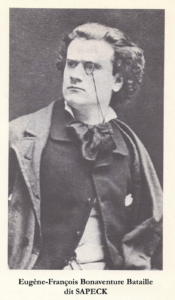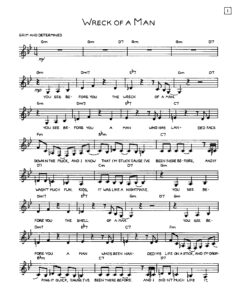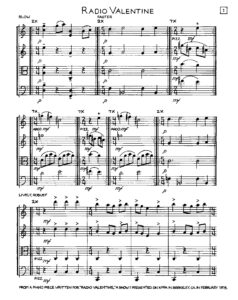My 17th string quartet was written during the pandemic. It consists of two movements: a brisk tune and round, strictly diatonic in C, E-flat, and A; and a slow movement in not-strictly-diatonic G. More may follow.
String Quartet 17: Lockdown
November 2nd, 2020 · 2 Comments
→ 2 CommentsTags: *Music · S
Announcement
October 25th, 2020 · Comments Off on Announcement
I have been asked by Norman Conquest, the indefatigable director of Black Scat Books, to post this announcement. Perhaps some of you will see fit to contribute to this useful reference work.
Comments Off on AnnouncementTags: *Words
The Illustrious Sapeck
October 20th, 2020 · 2 Comments
In the interest of metaphysical and pataphysical confusion, some of my entries in the upcoming second volume of Le Scat Noir Encyclopaedia are fictional, and some are factual. This one, on a famous Parisian prankster, is factual.
THE ILLUSTRIOUS SAPECK. Eugène Bataille (1853-1891), better known as the Illustrious Sapeck, is not to be confused with Eugène Battaille (1817-1882), the painter of historical and religious subjects, or with Eugène Bataille (1854?-?), the bass who enjoyed a long career with the Opéra-Comique and the Opéra de Paris.
This Bataille, as Sapeck, was admired by his colleagues as “the emperor of pranksters.” He sent out cards announcing his public appearances, in which he greeted the public in the gaudy costume of a “Hungarian composer,” or sat in a dogcart drawn by two horses, cheered on by hired street urchins. On one occasion, he shaved his head and painted it blue, explaining to the police that it “prevented dark thoughts.”
His exploits were inevitably ephemeral, but documented in the Bohemian press, often by his sometime accomplice Alphonse Allais. Like his operatic namesake, he was a gifted vocalist, equally adept at imitating dogs where dogs were prohibited, or at passing himself off as a “vocal inspector” at a girl’s school. Like his two-T namesake, he was also a painter, once giving a grocer a grisly sketch of a butchered rabbit, then sending his friends in to admire the priceless “original Sapeck.” He not only painted animals, but painted on them: the citizens of Honfleur were treated to a landscape of Normandy rendered in impasto on the curate’s donkey, and to the transformation of all the local horses into zebras.
He supplemented this career with cartoons for Scapin, Tout-Paris, La Lune Rousse, and other periodicals; illustrations for books by Coquelin Cadet, Léo Taxil, and others; and his own paper L’Anti-Concierge. His “Mona Lisa Smoking a Pipe,” shown at the Arts Incohérents in 1883, probably inspired Duchamp.
His friends were baffled when he moved to Oise at 30 to become a prefectural counselor. Six years later, he was committed to a mental hospital, where he died at 38.
The following year, Taxil published his sensational anti-Masonic hoax, The Devil in the 19th Century, under the name of “Dr. Bataille,” in memory of his late collaborator, “the illustrious Sapeck, the prince of jokers in the Latin Quarter.”
→ 2 CommentsTags: *Words · I
Wreck of a Man
October 12th, 2020 · 2 Comments
Here’s another song from White Knuckle Sandwich, giving me a chance to sing gloomy lyrics in my lower range. I’ve also performed this with David Gold adding an obbligato on viola and duck call.
→ 2 CommentsTags: *Music · W
Aleatoric Temperament and Boxing Kangaroo Rats
October 1st, 2020 · Comments Off on Aleatoric Temperament and Boxing Kangaroo Rats
In 2017, Black Scat Books published Le Scat Noir Encyclopaedia, which presented “all human knowledge in a single volume.” A sequel is now in preparation, offering even more of all human knowledge. I wrote a few entries, including these on music and popular entertainment.
ALEATORIC TEMPERAMENT. Rather than choosing pitches by the ratios of frequencies, or by an equal division of the scale, aleatoric temperament determines them by chance. Randomly generated integers give the number of pitches in the octave, and then their frequencies. If, for example, you obtain fifteen pitches between A440 and A880, you might then obtain the series 457, 463, 480, 514, 551, 603, 649, 707, 756, 787, 790, 824, 835, 837, and 861, and tune your instrument accordingly. You can, of course, use a different temperament for each octave.
BOXING KANGAROO RATS. In the late 19th century, the popularity of boxing matches between men and kangaroos, in both Australia and Europe, prompted American showmen to offer similar attractions. Kangaroos were rare and expensive, so other animals were substituted. America’s only native marsupial, the opossum, was easy to obtain, but its habit of playing dead when threatened failed to entertain audiences. Consequently, several outfits, including Pixley’s Dime Museum and Carter’s Combined Menagerie, turned to kangaroo rats. Although the rats did hop like kangaroos, they were too small to present a challenge to human boxers, and even the most sadistic crowds balked at watching a grown man punch a tiny defenseless animal. Boxing kangaroo rats are now a mere footnote in American popular entertainment.
Comments Off on Aleatoric Temperament and Boxing Kangaroo RatsTags: *Words · A
Index Cards (96)
September 24th, 2020 · 2 Comments
→ 2 CommentsTags: *Index Cards
Cries of Vendors
September 17th, 2020 · 2 Comments
A keyboard version of a bit of my String Quartet 15: harmonizations of two street vendors’ cries notated by Friedrich Weber in 1887.
→ 2 CommentsTags: *Music · C
The Morning Walk
September 10th, 2020 · Comments Off on The Morning Walk
In this gripping tale, our hapless narrator tries to reconcile the competing demands of the cerebral and physical. Here’s the first part; the whole thing is slated for the next issue of the Black Scat Review.
THE MORNING WALK
It was a beautiful spring morning, so I decided to take a walk.
The decision was not an easy one, since a walk would prevent me from doing other things. I could not, for example, both swim and walk, because swimming is done in water, and walking on land. Nor could I wash dishes and walk, because dishwashing requires standing at a sink. I could walk around the kitchen between dishes, taking a little stroll between a pot and a plate, but would have to alternate the two activities. Swimming and washing dishes, however, could be combined, if necessary, by placing the dishes in a pool or other body of water.
Not all activities are incompatible with walking. I could, for example, play music and walk at the same time. Many people do, particularly in marching bands. Some instruments have even been redesigned to be easier to carry. The celebrated bandleader John Philip Sousa, for example, took time out from writing his famous marches to create the modified tuba we know as the Sousaphone. This ingenious invention wraps around the player, freeing his or her hands. I have always regretted that Sousa never redesigned other bulky instruments. The marimba, for example, cannot lend its bright and distinctive timbre to parades. As I considered this, I felt the creative spark kindling within me, and yearned to complete the work he had left unfinished. But just as he could not write marches and redesign instruments at the same time, I could not take a walk and solve the problem of the marching marimba. True, nothing prevented me from thinking about it, as I placed one foot after the other, but I would have to leave my workbench behind…
Comments Off on The Morning WalkTags: *Words · M
String Quartet 16: Piano Pieces
September 1st, 2020 · 1 Comment
My 16th string quartet consists of arrangements of some of the piano music I’ve written over the years. Here’s “Radio Valentine,” written for a radio show in San Francisco long ago.
→ 1 CommentTags: *Music · S
String Quartet 15: On Melody in Speech
August 25th, 2020 · Comments Off on String Quartet 15: On Melody in Speech
In the course of my miscellaneous musical reading, I found an article by the organist and composer Friedrich (or, in England, Frederic) Weber, “On Melody in Speech,” in the Feb. 1887 issue of Longman’s Magazine (pp. 399-410). Weber notated the pitches and rhythms of the cries of several animals (dogs, birds, donkeys), and added some transcriptions of human speech. I don’t think his notations are particularly accurate, but I do like their wayward tunes and irregular rhythms, so I harmonized them for string quartet.
Comments Off on String Quartet 15: On Melody in SpeechTags: *Music · S








